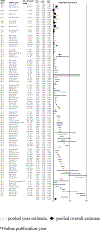Growth in Proportion and Disparities of HIV PrEP Use Among Key Populations Identified in the United States National Goals: Systematic Review and Meta-analysis of Published Surveys
- PMID: 32205721
- PMCID: PMC8022293
- DOI: 10.1097/QAI.0000000000002345
Growth in Proportion and Disparities of HIV PrEP Use Among Key Populations Identified in the United States National Goals: Systematic Review and Meta-analysis of Published Surveys
Abstract
Background: Pre-exposure prophylaxis (PrEP) use among populations most vulnerable to HIV as identified in the national HIV prevention goals is not fully known. This systematic review assessed trends of lifetime self-reported PrEP use and disparities among key populations.
Methods: We used the CDC HIV/AIDS Prevention Research Synthesis cumulative database of electronic and manual searches in MEDLINE, CINAHL, EMBASE, and PsycINFO from 2000 to 2019 to identify English-language primary studies reporting PrEP use. Two reviewers independently screened citations, extracted data, and assessed the risk of bias with the modified Newcastle-Ottawa Scale. We estimated pooled proportions and crude/adjusted odds ratio.
Results: We identified 95 eligible studies including 95,854 US-based survey respondents. A few studies (6.3%) focused on persons who inject drugs. In 2015-2017, men who have sex with men (MSM) had highest proportion of individuals who used PrEP over their lifetime [13.9% (95% confidence interval: 8.8 to 21.1), k (number of surveys) = 49] followed by Hispanic/Latinos [11.5 (7.1 to 18.1), 12], transgender women [11.2 (5.8 to 20.6), 5], and blacks [9.9 (8.3 to 11.8), 18]. Odds of PrEP use increased by 34%/year [odds ratio = 1.34/year (95% confidence interval: 1.09 to 1.64)] and significantly increased over time among MSM [1.53/year (1.21-1.93)] and blacks [1.44 (1.13-1.83)]. People in the Southern United States [9.9 (4.7-19.7), 8] and youth [7.3 (4.7-11.2), 8] had lower rates and did not demonstrate growth [0.94 (0.29-3.18); 0.82 (0.43-1.55)]. Odds of reporting lifetime PrEP use was twice [2.07 (1.27-3.38)] as great among MSM than non-MSM.
Conclusions: Proportions of PrEP use in published surveys have been growing, but remain low for people in the Southern United States and youth, and understudied in persons who inject drugs. Limitations include few studies in certain years, whereas strengths include a large number of respondents. Culturally tailored approaches targeting vulnerable populations are essential in increasing PrEP use to reduce disparities in HIV acquisition.
Figures



References
-
- Sullivan PS, Smith DK, Mera-Giler R, et al. The impact of pre-exposure prophylaxis with TDF/FTC on HIV diagnoses, 2012–2016, United States. Paper presented at: AIDS; 2018; Amsterdam, Netherlands.
Publication types
MeSH terms
Grants and funding
LinkOut - more resources
Full Text Sources
Medical
Miscellaneous

